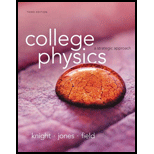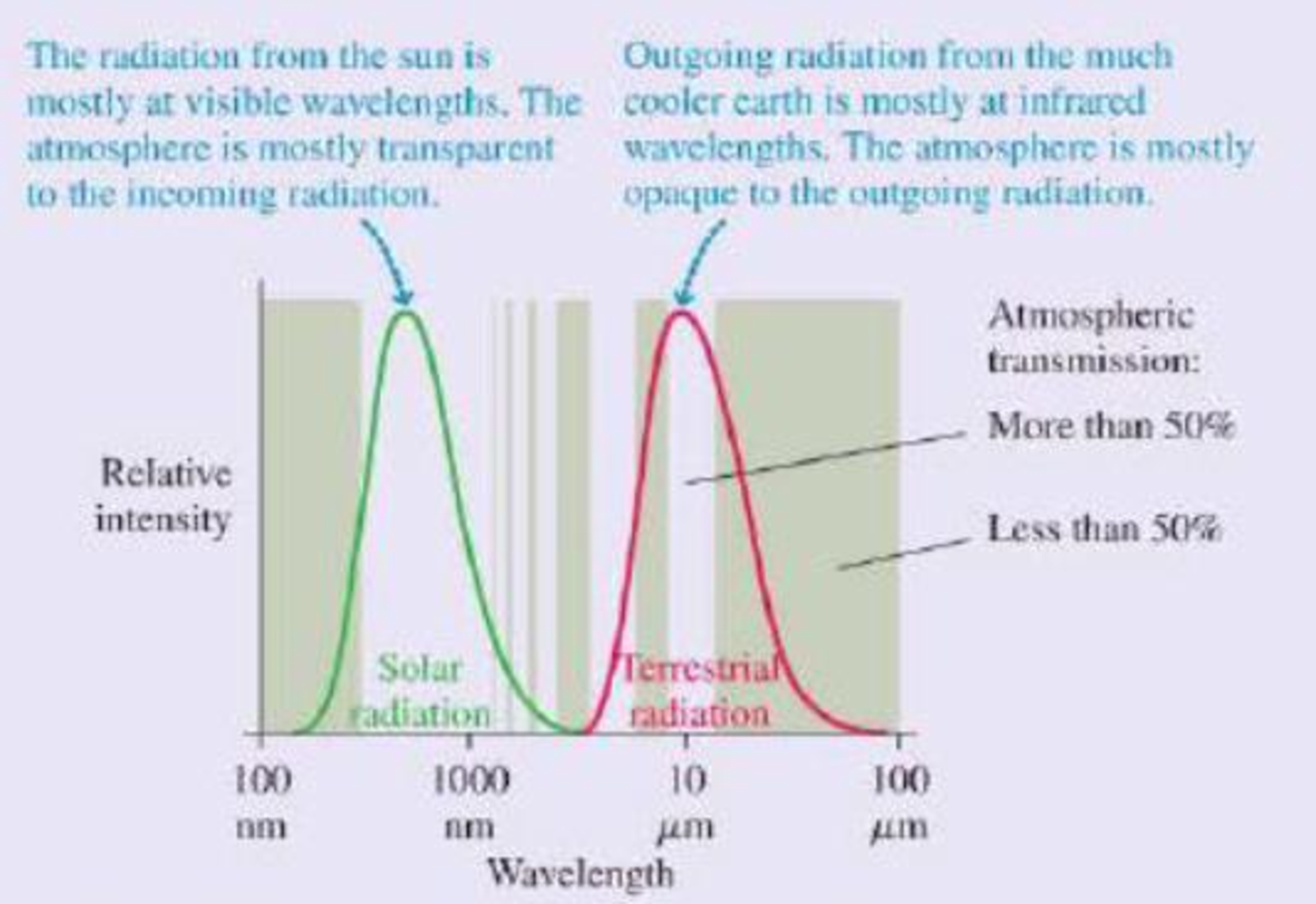
The Greenhouse Effect and Global Warming
Although seasons come and go, on average the earth’s climate is very steady. To maintain this stability, the earth must radiate thermal energy—electromagnetic waves—back into space at exactly the same average rate that it receives energy from the sun. Because the earth is much cooler than the sun, its thermal radiation is long-wavelength infrared radiation that we cannot see. A straightforward calculation using Stefan's law finds that the average temperature of the earth should be –18°C, or 0°F, for the incoming and outgoing radiation to lie in balance.
This result is clearly not correct; at this temperature, the entire earth would be covered in snow and ice. The measured global average temperature is actually a balmier 15°C, or 59°F. The straightforward calculation fails because it neglects to consider the earth’s atmosphere. At visible wavelengths, as the figure shows, the atmosphere has a wide “window” of transparency, but this is not true at the infrared wavelengths of the earth’s thermal radiation. The atmosphere lets in the visible radiation from the sun, but the outgoing thermal radiation from the earth sees a much smaller “window.” Most of this radiation is absorbed in the atmosphere.

Thermal radiation curves for the sun and the earth. The shaded bands show regions for which the atmosphere is transparent (no shading) or opaque (shaded) to electromagnetic radiation.
Because it’s easier for visible radiant energy to get in than for infrared to get out, the earth is warmer than it would be without the atmosphere. The additional warming of the earth’s surface because of the atmosphere is called the greenhouse effect. The greenhouse effect is a natural part of the earth’s physics; it has nothing to do with human activities, although it’s doubtful any advanced life forms would have evolved without it.
The atmospheric gases most responsible for the greenhouse effect are carbon dioxide and water vapor, both strong absorbers of infrared radiation. These greenhouse gases are of concern today because humans, through the burning of fossil fuels (oil, coal, and natural gas), are rapidly increasing the amount of carbon dioxide in the atmosphere. Preserved air samples show that carbon dioxide made up 0.027% of the atmosphere before the industrial revolution. In the last 150 years, human activities have increased the amount of carbon dioxide by nearly 50%, to about 0.040%. By 2050, the carbon dioxide concentration will likely increase to 0.054%, double the pre-industrial value, unless the use of fossil fuels is substantially reduced.
Carbon dioxide is a powerful absorber of infrared radiation. And good absorbers are also good emitters. The carbon dioxide in the atmosphere radiates energy back to the surface of the earth, warming it. Increasing the concentration of carbon dioxide in the atmosphere means more radiation: this increases the average surface temperature of the earth. The net result is global warming.
There is strong evidence that (he earth has warmed nearly 1°C in the last 100 years because of increased greenhouse gases. What happens next? Climate scientists, using sophisticated models of the earth’s atmosphere and oceans, calculate that a doubling of the carbon dioxide concentration will likely increase the earth’s average temperature by an additional 2°C (≈ 3°F) to 6°C (≈9°F) There is some uncertainty in these calculations; the earth is a large and complex system. Perhaps the earth will get cloudier as the temperature increases, moderating the increase. Or perhaps the arctic ice cap will melt, making the earth less reflective and leading to an even more dramatic
But the basic physics that leads to the greenhouse effect, and to global warming, is quite straightforward. Carbon dioxide in the atmosphere keeps the earth warm; more carbon dioxide will make it warmer. How much warmer? That’s an important question, one that many scientists around the world are attempting to answer with ongoing research. But large or small, change is coming. Global warming is one of the most serious challenges facing scientists, engineers, and all citizens in the 21st century.
The following questions are related to the passage “The Greenhouse Effect and Global Warming” on the previous page.
The thermal radiation from the earth’s surface peaks at a wavelength of approximately 10 μm. If the surface of the earth warms, this peak will
- A. Shift to a longer wavelength.
- B. Stay the same.
- C. Shift to a shorter wavelength.
Want to see the full answer?
Check out a sample textbook solution
Chapter P Solutions
College Physics: A Strategic Approach (3rd Edition)
Additional Science Textbook Solutions
Conceptual Integrated Science
Essential University Physics (3rd Edition)
Tutorials in Introductory Physics
Physics for Scientists and Engineers: A Strategic Approach with Modern Physics (4th Edition)
Applied Physics (11th Edition)
Physics for Scientists and Engineers with Modern Physics
- Comparing two different types of electromagnetic waves, infrared and ultraviolet, we can say thatA. Infrared has a longer wavelength and higher frequency than ultraviolet.B. Infrared has a shorter wavelength and higher frequency than ultraviolet.C. Infrared has a longer wavelength and lower frequency than ultraviolet.D. Infrared has a shorter wavelength and lower frequency than ultraviolet.arrow_forwardMay 27, 2022 Physics - Electromagnetic Radiation Date Pd_______ Name 1. Which of the following wave characteristics is the same for any electromagnetic wave traveling through empty space? A. frequency B. period C. speed D. wavelength 2. Radio stations use radio waves to transmit electromagnetic signals. Which of the following best compares radio waves to other waves on the electromagnetic spectrum? A. Radio waves have the highest frequency of all electromagnetic waves. B. Radio waves have the longest wavelength of all electromagnetic waves. C. The frequency of radio waves is close to the frequency of ultraviolet radiation. D. The wavelength of radio waves is close to the wavelength of visible light waves. 3. Electromagnetic radiation is used in many forms of communication. Electromagnetic waves with relatively long wavelengths are often used to transmit signals because these waves travel easily around objects. Which type of electromagnetic radiation is best for transmitting signals…arrow_forwardOzone layer One method of estimating the thickness of the ozone layer is to use the formula In Io - In I = kx, where I, is the intensity of a particular wavelength of light from the sun before it reaches the atmosphere, I is the in- tensity of the same wavelength after passing through a layer of ozone x centimeters thick, and k is the absorption con- stant of ozone for that wavelength. Suppose for a wave- length of 3176 X 10 8 cm with k - 0.39, Io/I is measured as 1.12. Approximate the thickness of the ozone layer to the nearest 0.01 centimeter.arrow_forward
- As we go along the electromagnetic spectrum starting at radio waves and ending on gamma rays, which of the following do we discover? A. That the energy of the waves decreases, and the wavelength also decreases. B. That the energy of the waves decreases, and the wavelength increases. C. That the energy of the waves increases, and the wavelength also increases. D.That the energy of the waves increases, and the wavelength decreases.arrow_forward1. If microwaves have a longer wavelength than ultraviolet waves, which type of wave has less energy? A. ultraviolet B. microwaves C. Both types of waves have the same energy. D. Wavelength cannot be used to determine energy. Gamma rays are the highest energy waves in the electromagnetic spectrum. Using the diagram which region would BEST represent gamma rays? A 2. A. Region A B. Region B C. Region C D. Region Darrow_forwardRadio waves have the lowest frequency of all the electromagnetic waves. What does the frequency of radio waves say about the energy they carry? a.Radio waves carry high amounts of energy. b.Radio waves carry low amounts of energy. c.The energy carried in all Electromagnetic waves is the samearrow_forward
- 2. Radio stations use radio waves to transmit electromagnetic signals. Which of the following best compares radio waves to other waves on the electromagnetic spectrum? A. Radio waves have the highest frequency of all electromagnetic waves. B. Radio waves have the longest wavelength of all electromagnetic waves. C. The frequency of radio waves is close to the frequency of ultraviolet radiation. D. The wavelength of radio waves is close to the wavelength of visible light waves.arrow_forward1. Which part of the electromagnetic spectrum has a higher frequency than ultraviolet waves? a. infrared b. microwaves c. x-rays d. none of these 2. Which part of the electromagnetic spectrum has a longer wavelength than visible light? a. gamma rays b. radio waves c. ultraviolet waves d. X-rays 3. Which of the given regions of the electromagnetic spectrum are arranged according to decreasing wavelength? a. X-rays, gamma rays, ultraviolet, infrared b. microwaves, infrared, gamma rays, X-rays c. gamma rays, X-rays, microwaves, radio waves d. radio waves, microwaves, X-rays, gamma raysarrow_forwardWhich of the following is NOT related to the contradiction between Maxwell’s theory of electromagnetism and Newton’s laws of mechanics? A. Maxwell’s theory implies that the speed of light is constant in all inertial frames of reference. B. Einsteinian relativity proves that ether, which is thought to be the medium of light, does not exist. C. Newtonian laws show that magnitude of quantities like speed vary according to inertial frames. D. Galilean transformations predict that light speed in an inertial reference frame would be c’ = c + v.arrow_forward
- Which of the following lists electromagnetic radiations from lowest to highest energy? A. radio waves, microwaves, ultraviolet radiation, visible light B. microwaves, radio waves, visible light, X-rays C. radio waves, infrared radiation, visible light, ultraviolet radiation D. gamma radiation, infrared radiation, visible light, X-raysarrow_forwardAs we go along the electromagnetic spectrum starting at radio waves and ending on gamma rays, which of the following do we discover? A. That the speed of the waves stays constant. B. That the speed of the waves increases.arrow_forwardThis is an infrared thermometer image of a house at night. It can be used to find heat leak in a house. 61 L https://www.digitaltrends.com/home/use-infrared-thermometer-easily-spot-heat-leaks-house/ a. The bright parts are higher temperature than the dark regions. b. The bright parts indicate the emitted E-M radiation with longer wavelength. c. The bright parts indicate high intensity of E-M radiation. d. The bright parts indicate the emitted E-M radiation with high frequency. e. The brightness of image doesn't mean anything.arrow_forward
 AstronomyPhysicsISBN:9781938168284Author:Andrew Fraknoi; David Morrison; Sidney C. WolffPublisher:OpenStax
AstronomyPhysicsISBN:9781938168284Author:Andrew Fraknoi; David Morrison; Sidney C. WolffPublisher:OpenStax Physics for Scientists and Engineers with Modern ...PhysicsISBN:9781337553292Author:Raymond A. Serway, John W. JewettPublisher:Cengage Learning
Physics for Scientists and Engineers with Modern ...PhysicsISBN:9781337553292Author:Raymond A. Serway, John W. JewettPublisher:Cengage Learning Physics for Scientists and EngineersPhysicsISBN:9781337553278Author:Raymond A. Serway, John W. JewettPublisher:Cengage Learning
Physics for Scientists and EngineersPhysicsISBN:9781337553278Author:Raymond A. Serway, John W. JewettPublisher:Cengage Learning







